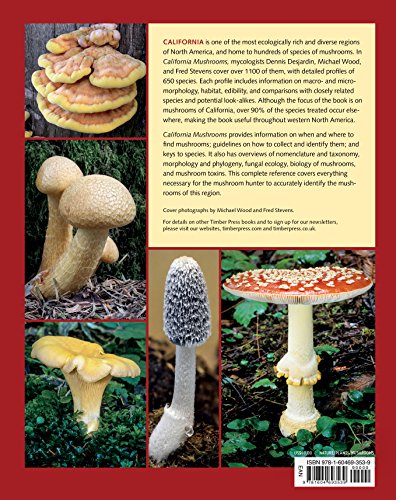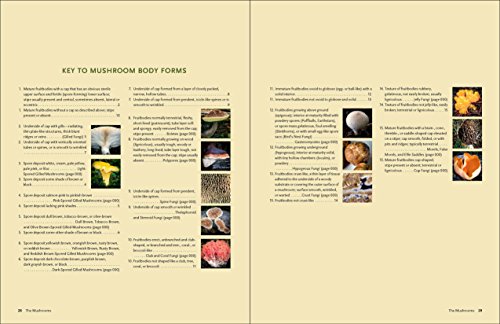




Full description not available
K**T
Wealth of mycologocal information
Though a bit outdated a d mycologists have made innumerable changes to the taxonomy of various species, it is a plethora of still very useful information, not the keaat of which being advice on how to identify at least the genus.
T**.
Great book but has issues
So here’s my take. Great book and highly suggest for anyone looking to get into mushrooms. A few issues though from my perspective. I’ll go chronologically.The contents page doesn’t have galerinas or Pholiotinas listed. Or an area for toxic mushrooms in general listed. This means to find out if it is, you must be looking at it and follow the books key (issue two) at the beginning of each “chapter”.The issue with these keys is that unless you have truly taken the time to become rather familiar with mushroom morphology and macromorphology , they can be a little hard to follow. Reads very much like a textbook for a class (maybe the authors are trying to get their book to be the new required text for classes?) rather than for your everyday lay person looking to get into mushroom hunting. Don’t get me wrong, it’s all terms that everyone should learnMy last issue is with those silly little psilocybe, or in this case, lack there of. I can only speculate as to why the authors decided to omit numerous species. Quite possibly for the best but when I spend that kind of money on a book called “California Mushrooms: The Comprehensive Identification Guide” I’d expect it to list ALL mushrooms found in California. Not leave me scratching my head as to certain ones.That’s my take on the book. Very happy I purchased it. Not exactly structured for foragers. Geared more towards mycologists. Have to purchase other books to get a complete guide to California’s mushrooms. Hope this helps give you all info for an informed decision.
C**R
Excellent
For a California mycophile Professor Desjardin has laid a treasure in my lap. Now after three years of drought I need rain to put it to use. In Marin county last year I probably managed to find about 20 species of mushroom over the entire season while my buddy Bob Stewart up in Arcata approached 200. If I had a coffee table I would but “California Mushrooms” on it. Because, despite the seasonally-so-far lack of shrooms, I pick it up and read through one section after another. I wonder whether the older standard reference book we all know will fade. (I lobby its author to bring it up to date.) Of course our professor author needs not resort to humor as his predecessor did, but I would have like a little more help with synonyms. That is what us old guys, who learned taxonomy a while ago, now use as an excuse to use older claudistics which can be applied in the field to identify species. This is not a problem in this book. But more synonyms by way of common names and confused scientific names would have been useful.The pictures in the book are excellent. It doesn’t quite match the weight of “Lichens of North America,” but maybe equals Jespson’s flora for which people had handy cloth carrying cases. I wonder if the publisher will reduce it too a handbook to carry in the field. This book is a must for shroomers in California.Charlie Fisher, author of “Meditation in the Wild” and “Dismantling Discontent.”
T**S
I also recommended it as one of the options for students to ...
This is not a completely unbiased review since the authors are friends, and I did get a free copy for providing one photo that was used in the book. However, I teach a mushroom course and bought four more copies of this book figuring that I would need some extras. I also recommended it as one of the options for students to buy and use in the course. I have just started to use it myself and in the class, and so far I’m very happy with it. More importantly students seem happy with it and are able to use it to identify mushrooms that they have not seen before. The quick summary is that the photos are beautiful, the keys generally work well, and the mushrooms included in it seem to be all the most common ones in our area. I especially like the coverage of the mycenoid mushrooms and Agaricus species, and inclusion of some of the distinctive crust fungi. Of course it does not have everything in it, and name changes have occurred since it went to press, but this can be said of all mushroom field guides. Nevertheless, I would still rank it as the best option available for our area, and I recommend it to anyone interested in learning California mushrooms.
L**R
Great book and made a great gift!
I bought this book as a birthday gift for my boyfriend. He has always been interested in learning more about mushrooms since they have been seen so often on our hikes all through California. Since this is specific to our state, it will definitely come in handy. My boyfriend can be a tough one to buy for, but I am pleased to say, he is very happy with this book. He has spent hours reading it already and has already brought mushrooms home in an attempt to identify them. The pictures are truly beautiful as well as amazing content. So thank you to the author for helping me get him a great gift he’s extremely happy, and even excited about!
S**S
Finally, a new guide for the Western States.
California Mushrooms is the best field guide published in a decade. I say field guide loosely as it is much too heavy to haul around in the field. But don't be put off by that. Most mushroom identification happens after the hunt, at home in a quiet space. The introductory material is thorough, easy to understand, and leads one with confidence into the keys. The keys are logical and clear. The photograph which accompanys each described mushroom is true to life. This alone makes the book worth every penny. I have been a mushroom hunter for 34 years, and a member of the Fungus Federation of Santa Cruz Governing board. Even with so much experience, positive identification can be elusive. While as previous reviewers have said, no one book can do it all, California Mushrooms comes very close. In the last 10 years, new field guides available in the U.S. have described species found largely in the eastern states, and very little new work was available specifically for the western states
A**O
El rigor científico
El Libro está avalado por un gran rigor científico, pero teniendo en cuenta la fecha de su publicación, no recoge los cambios recientes como consecuencia de los actuales estudios filogenéticos. Se echa en falta los nuevos nombres de los géneros que anteriormente se agrupaban en el Género Boletus.
Trustpilot
4 days ago
1 month ago